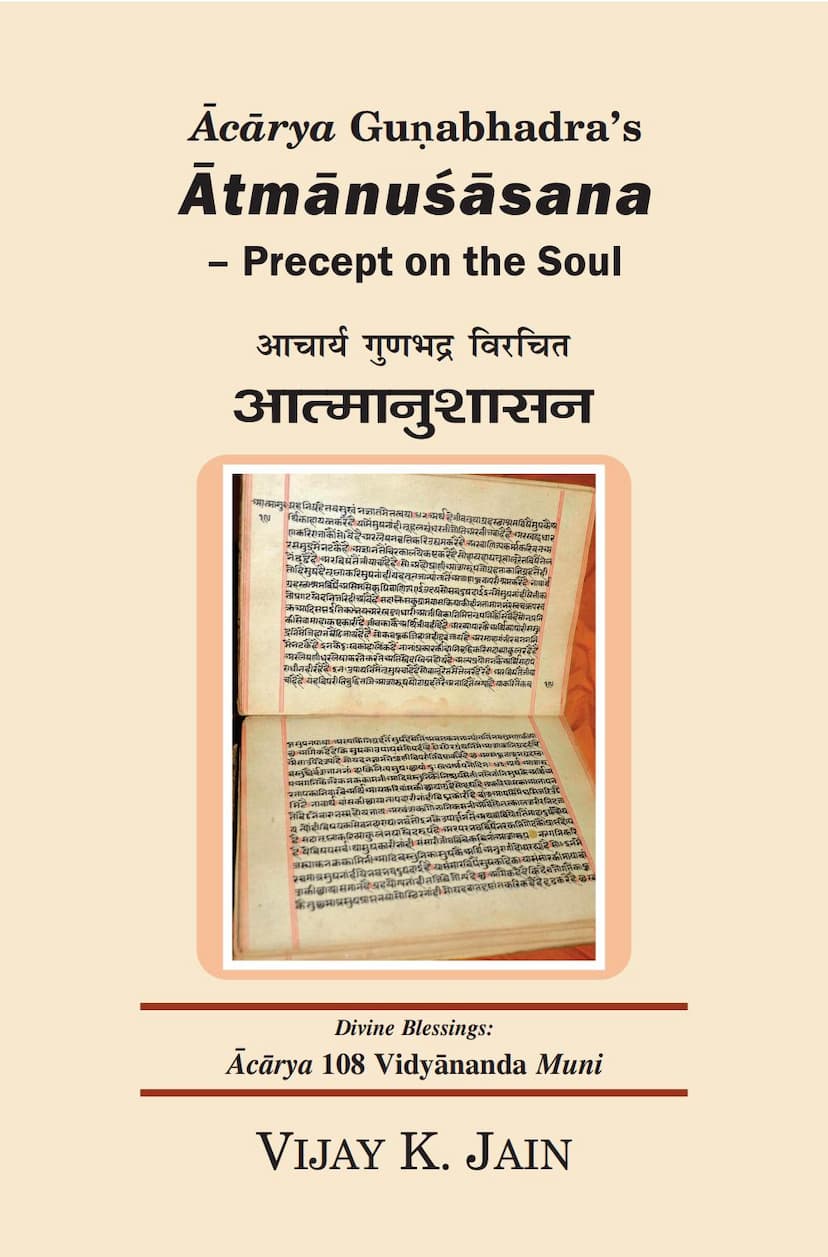Aatmanushasan
Added to library: September 1, 2025

Summary
Here's a comprehensive summary of the Jain text "Ātmānuśāsana" by Ācārya Guṇabhadra, based on the provided text:
Ātmānuśāsana: A Precept on the Soul
"Ātmānuśāsana," meaning "Precept on the Soul," is a profound Jain scripture authored by the venerable Ācārya Guṇabhadra (estimated to have lived in the latter half of the 8th century CE). The text, comprising 270 verses (though some editions mention 269), serves as a guide to self-discipline and the realization of the soul's true nature. It employs fifteen distinct poetic meters, enhancing its literary richness and making complex spiritual concepts accessible.
Core Message and Purpose:
The central aim of Ācārya Guṇabhadra in composing "Ātmānuśāsana" is to expound a path to happiness by eradicating misery. He acknowledges that the teachings might initially seem bitter, akin to a strong medicine for a sick person, but assures the reader that the ultimate outcome will be profoundly beneficial. The work emphasizes the paramount importance of Dharma (righteous conduct) as the sole pursuit in life, regardless of one's current state of happiness or misery. Dharma is presented as the source of happiness, increasing joy in times of well-being and alleviating suffering during distress.
Key Themes and Teachings:
- The Nature of the Soul and Self-Realization: The text delves into the intrinsic nature of the soul, advocating for its realization through disciplined conduct. It distinguishes between the external body and the eternal soul, urging readers to identify with the latter.
- The Path to Liberation (Moksha): "Ātmānuśāsana" outlines the steps towards liberation, emphasizing the significance of Right Faith (Samyagdarśana) as the foundational element for Right Knowledge (Samyagjñāna) and Right Conduct (Samyakcāritra). Without Right Faith, other spiritual practices lose their value.
- The Importance of Dharma: Dharma is presented as the cause of happiness and is never contradictory to its own effects. It is to be pursued through thought, word, and deed, by doing, causing to be done, and approving of righteous actions. The world's safety and well-being are intrinsically linked to the presence of Dharma.
- Renunciation and Detachment: The text strongly advocates for renunciation of worldly possessions and sensory pleasures, likening them to poison. It highlights that true happiness lies in detachment, while attachment leads to misery. Even worldly achievements like kingship are ultimately impermanent and should be relinquished for the pursuit of eternal bliss.
- The Impermanence of the Body and Worldly Life: Ācārya Guṇabhadra vividly describes the body as impure, a source of suffering, and ultimately perishable. He warns against attachment to the body and worldly relationships, which are transient and ultimately cause more pain. Life itself is fleeting, compared to a fruit falling from a tree, making the pursuit of spiritual goals essential.
- The Dangers of Delusion (Moha) and Passions (Kashāya): The text identifies delusion as the root cause of attachment and aversion, which in turn lead to suffering. It urges the reader to burn the seed of delusion with the fire of knowledge. Passions like anger, ego, deceit, and greed are depicted as the primary obstacles to peace and well-being.
- The Role of Austerities (Tapa) and Knowledge (Jñana): Austerities are presented as a powerful means to overcome obstacles, vanquish inner enemies, and attain liberation. Knowledge, particularly scriptural knowledge, is crucial for understanding the true nature of reality and purifying the soul.
- The Virtues of Ascetics and Wise Men: The scripture extols the virtues of ascetics who are detached from worldly desires, practice austerities, and remain steadfast in their spiritual path. It contrasts their self-contentment with the unquenchable desires of householders.
- Discernment and Self-Control: The importance of discerning between what is beneficial and harmful is repeatedly stressed. Self-control over the senses and the mind is paramount for progress on the spiritual path.
- The Nature of True Happiness: True happiness is depicted as an internal state, arising from self-control and detachment, rather than from external possessions or sensory pleasures. The ultimate happiness is the soul's innate nature, realized upon liberation.
- Critique of Worldly Attachments: The text offers a stark critique of worldly attachments, including those to wealth, family, and the body itself, illustrating their transient nature and ultimate contribution to suffering. The allure of women is particularly cautioned against, depicted as a significant snare for ascetics.
- The Cycle of Karma and Liberation: The book explains how karma binds the soul and how, through the progressive stages of Right Faith, Right Knowledge, Right Conduct, and Right Austerities, one can break free from this cycle and attain liberation.
Author's Lineage and Context:
Ācārya Guṇabhadra was a disciple of Ācārya Jinasena and Ācārya Dasaratha, who were themselves disciples of Ācārya Vīrasena. This lineage highlights a strong tradition of profound scriptural scholarship and austerity. The work is also noted for its influence from earlier scriptures and philosophers like Ācārya Kundakunda, Ācārya Samantabhadra, and Bhartṛhari.
Publication and Sponsorship:
This particular English rendition is published by Vikalp Printers, Dehradun, and is credited to Vijay K. Jain. The publication emphasizes that the work is non-copyright and can be reproduced and translated freely. The publication also carries divine blessings from Ācārya 108 Vidyānanda Muni.
In essence, "Ātmānuśāsana" is a comprehensive spiritual manual that guides the reader towards self-mastery and ultimate liberation by shedding worldly illusions and embracing the eternal truth of the soul through righteous conduct, knowledge, and austerities.